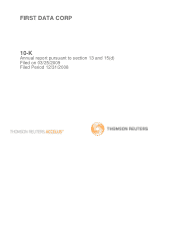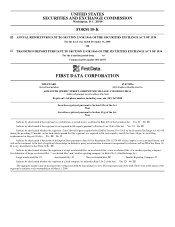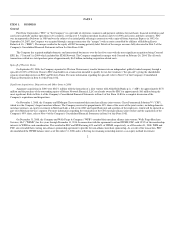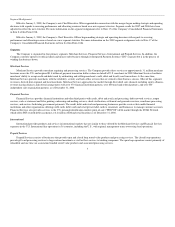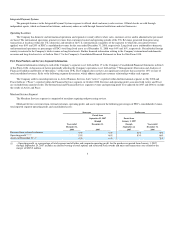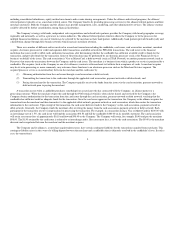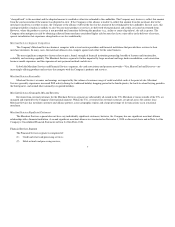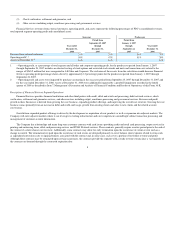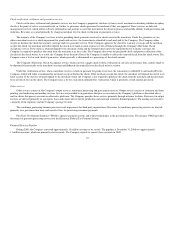First Data 2008 Annual Report Download - page 7
Download and view the complete annual report
Please find page 7 of the 2008 First Data annual report below. You can navigate through the pages in the report by either clicking on the pages listed below, or by using the keyword search tool below to find specific information within the annual report.
including consolidated subsidiaries, equity method investments and revenue sharing arrangements. Under the alliance and referral programs, the alliance/
referral partners typically act as a merchant referral source. The Company benefits by providing processing services for the alliance/referral partners and their
merchant customers. Both the Company and the alliance may provide management, sales, marketing, and other administrative services. The alliance strategy
could be affected by further consolidation among financial institutions.
The Company's strategy with banks, independent sales organizations and referral/sales partners provides the Company with broad geographic coverage,
regionally and nationally, as well as a presence in various industries. The alliance/referral partner structure allows the Company to be the processor for
multiple financial institutions, any one of which may be selected by the merchant as their bank partner. Additionally, bank partners provide brand loyalty and
a distribution channel through their branch networks which increases merchant retention.
There are a number of different entities involved in a merchant transaction including the cardholder, card issuer, card association, merchant, merchant
acquirer, electronic processor for credit and signature debit transactions, and debit network for PIN-debit transactions. The card issuer is the financial
institution that issues credit or debit cards, authorizes transactions after determining whether the cardholder has sufficient available credit or funds for the
transaction, and provides funds for the transaction. Some of these functions may be performed by an electronic processor (such as the Financial Services
business) on behalf of the issuer. The card association is Visa or MasterCard, a debit network (such as STAR Network) or another payment network (such as
Discover) that routes the transactions between the Company and the card issuer. The merchant is a business from which a product or service is purchased by a
cardholder. The acquirer (such as the Company or one of its alliances) contracts with merchants to facilitate their acceptance of cards. A merchant acquirer
may do its own processing or, more commonly, may outsource those functions to an electronic processor such as the Merchant Services segment. The
acquirer/processor serves as an intermediary between the merchant and the card issuer by:
(1) Obtaining authorization from the card issuer through a card association or debit network;
(2) Transmitting the transaction to the card issuer through the applicable card association, payment network or debit network; and
(3) Paying the merchant for the transaction. The Company typically receives the funds from the issuer via the card association, payment network or
debit network prior to paying the merchant.
A transaction occurs when a cardholder purchases something from a merchant who has contracted with the Company, an alliance partner or a
processing customer. When the merchant swipes the card through the POS terminal (which is often sold or leased, and serviced by the Company), the
Company obtains authorization for the transaction from the card issuer through the card association, payment network or debit network, verifying that the
cardholder has sufficient credit or adequate funds for the transaction. Once the card issuer approves the transaction, the Company or the alliance acquires the
transaction from the merchant and then transmits it to the applicable debit network, payment network or card association, which then routes the transaction
information to the card issuer. Upon receipt of the transaction, the card issuer delivers funds to the Company via the card association, payment network or
debit network. Generally, the Company funds the merchant after receiving the money from the card association, payment network or debit network. Each
participant in the transaction receives compensation for processing the transaction. For example, in a transaction using a Visa or MasterCard for $100.00 with
an interchange rate of 1.5%, the card issuer will fund the association $98.50 and bill the cardholder $100.00 on its monthly statement. The card association
will retain assessment fees of approximately $0.10 and forward $98.40 to the Company. The Company will retain, for example, $0.40 and pay the merchant
$98.00. The $1.50 retained by the card issuer is referred to as interchange and it, like assessment fees, is set by the card association. The $0.40 is the merchant
discount and is negotiated between the merchant and the merchant acquirer.
The Company and its alliances, as merchant acquirers/processors, have certain contingent liabilities for the transactions acquired from merchants. This
contingent liability arises in the event of a billing dispute between the merchant and a cardholder that is ultimately resolved in the cardholder's favor. In such a
case, the transaction is
6

